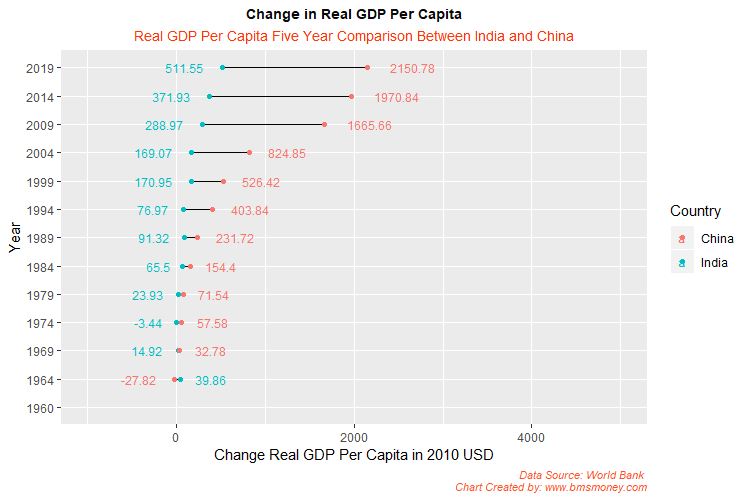Once upon a time per capita GDP of India was higher than China. Now GDP per capita of India is one-sixth of China's GDP per capita. In 2021 GDP per capita of India was $1936 whereas the GDP per capita of China stood at $11188.

- Till 1979 GDP per capita of China was lower compared to the GDP per Capita of India.
- In 1984 it was almost identical, India had a GDP per Capita of 471 USD. Chinese number was $480.42. China started economic reforms in 1978-79.
- The reform started to show its impact by 1984. As GDP per capita of China increased by approximately $150 in a 5-6 year time period. for India, the growth was modest at $65.
- By 1999, China's GDP Per capita became almost twice of GDP per capita of India.
- As of 2021, the GDP per capita of China is 5.8 times of GDP per capita of India. In 1979, the GDP per Capita of India was 1.25 times the GDP per capita of China.
- In 2021 GDP per capita of India was $1936 whereas the GDP per capita of China stood at $11188.
How China Raced Ahead of India
There were multiple reasons why China raced ahead of India:
- Almost 12 Years Head Start in Economic Reforms: In late 1978, the People's Republic of China embarked on a bold path of economic transformation, instituting comprehensive economic reforms that laid the groundwork for exponential future growth. This marked a profound shift from the rigid, state-controlled economic model to a more open and market-oriented system. The reforms, often referred to as the "opening-up policy", reoriented China towards global economic engagement, providing a robust foundation for economic acceleration and sustainable development.
On the other hand, during the same period, India pursued a largely planned economic structure underpinned by a strong element of central direction and a closed-door policy. This approach primarily revolves around protectionism, limited foreign involvement, and heavily regulated domestic enterprises. Consequently, India's economy during this era was marked by a slower pace of growth, with limited opportunities for international trade and foreign direct investment.
In the broader historical context, these contrasting economic policies and the strategies adopted by China and India during the late 70s and early 80s played significant roles in shaping their respective economic trajectories. China's focus on economic liberalization and openness facilitated its spectacular rise as a global economic powerhouse. Meanwhile, India's decision to maintain a planned and closed economy throughout this period had both benefits and drawbacks, ultimately leading to a different pace and pattern of economic development.
-
Authoritarian vs Democratic Government: China's political landscape is characterized by a centralized, authoritarian regime, wherein the power largely resides in the hands of the ruling party. This structure, marked by limited opportunities for public dissent, often facilitates swift policy decisions and changes. The Chinese government can efficiently push reforms, shape economic strategies, and make high-stakes decisions without the need to extensively negotiate with opposition parties or appease various public sentiments.
Contrastingly, India follows a democratic system of governance, which, by nature, is more pluralistic and inherently complex. The decision-making process in such a framework can often be challenging and protracted due to the necessity of achieving consensus among diverse political parties, regional interests, and social groups. Political decisions need to navigate through various levels of government, opposition critiques, public opinion, and legal scrutiny. This democratic structure, while fostering an environment of political diversity and public participation, might sometimes slow the pace of reforms and policy implementation.
These differing political structures undeniably influence the countries' respective abilities to respond swiftly to economic needs and societal challenges. China's top-down approach allows for rapid policy shifts and efficient decision-making, while India's democratic ethos ensures a more participatory approach to policy-making, albeit at a potentially slower pace. Both systems offer their own unique strengths and challenges, reflecting the complexities of governance in large, diverse nations.
-
Top Performing Funds for You
Top Performing Equity Funds Top Performing Debt Funds Top Performing Hybrid FundsWe will leave you with some other charts of real GDP per capita comparison between India and China.

